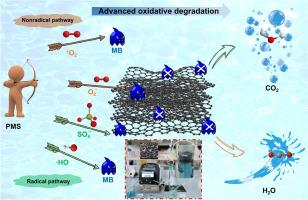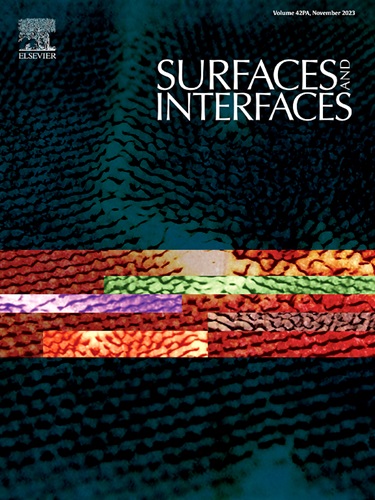Rapid preparation of N,P co-doped carbon for advanced oxidative degradation of wastewater
IF 5.7
2区 材料科学
Q2 CHEMISTRY, PHYSICAL
引用次数: 0
Abstract
Heteroatom-doped porous carbon materials are highly favored as catalysts for activating persulfates in the oxidative degradation of organic pollutants due to their low metal leaching risk and cost-effectiveness. Nonetheless, the complex process of creating heteroatom-doped carbon materials often results in suboptimal doping effects. This study uses N,P-enriched plants (Eichhornia crassipes after being used for nutrient-rich water remediation) as a raw material to prepare N-P co-doped catalysts in a single step. We thoroughly investigated their performance and mechanisms in dye degradation. The findings demonstrated that the adsorbent, with its rich pore structures, surface chemical functional groups, and graphite defect structures, could completely degrade a 100 mg L−1 MB solution within 20 min. Free radical quenching experiments and EPR analysis confirmed the presence of •OH, SO4•—, O2•— and 1O2, verifying their oxidative contributions. Moreover, it was determined that the non-radical pathway (1O2 oxidation) primarily drives the oxidative degradation in this system. Additionally, tests using a small-scale fixed-bed reactor and interference resistance highlighted the practical application potential of the adsorbent developed in this study. This study not only offers a dual solution for tackling nutrient enrichment and organic pollution in water bodies but also introduces a straightforward method for preparing N, P co-doped catalysts, significantly benefiting environmental protection.

快速制备用于废水高级氧化降解的 N、P 共掺杂碳
掺杂杂原子的多孔碳材料因其金属沥滤风险低和成本效益高,在有机污染物的氧化降解过程中作为活化过硫酸盐的催化剂备受青睐。然而,杂原子掺杂碳材料的复杂制备过程往往会导致掺杂效果不理想。本研究以富含 N、P 的植物(用于富营养化水体修复后的 Eichhornia crassipes)为原料,一步制备出 N-P 共掺催化剂。我们深入研究了它们在染料降解过程中的性能和机理。研究结果表明,该吸附剂具有丰富的孔隙结构、表面化学官能团和石墨缺陷结构,可在 20 分钟内完全降解 100 mg L-1 的甲基溴溶液。自由基淬灭实验和 EPR 分析证实了 -OH、SO4--、O2-- 和 1O2 的存在,验证了它们的氧化作用。此外,还确定非自由基途径(1O2 氧化)是该系统中氧化降解的主要驱动力。此外,使用小规模固定床反应器和抗干扰性能进行的测试凸显了本研究开发的吸附剂的实际应用潜力。本研究不仅为解决水体中营养物质富集和有机物污染问题提供了双重解决方案,还介绍了制备 N、P 共掺催化剂的简单方法,极大地促进了环境保护。
本文章由计算机程序翻译,如有差异,请以英文原文为准。
求助全文
约1分钟内获得全文
求助全文
来源期刊

Surfaces and Interfaces
Chemistry-General Chemistry
CiteScore
8.50
自引率
6.50%
发文量
753
审稿时长
35 days
期刊介绍:
The aim of the journal is to provide a respectful outlet for ''sound science'' papers in all research areas on surfaces and interfaces. We define sound science papers as papers that describe new and well-executed research, but that do not necessarily provide brand new insights or are merely a description of research results.
Surfaces and Interfaces publishes research papers in all fields of surface science which may not always find the right home on first submission to our Elsevier sister journals (Applied Surface, Surface and Coatings Technology, Thin Solid Films)
 求助内容:
求助内容: 应助结果提醒方式:
应助结果提醒方式:


